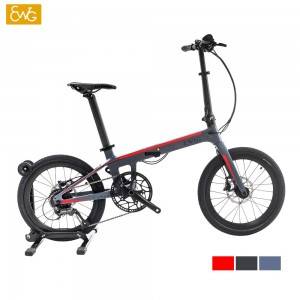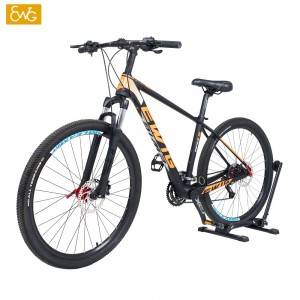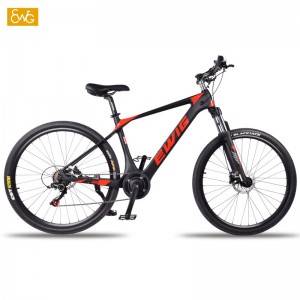What we call carbon fiber is actually a composite material with carbon as the main material. Carbon fiber composite material is not the only material in bicycle frames, rims, and carbon strips. This is because the ultra-high rigidity of carbon fiber has a technological premise. When the material is 100% carbon fiber composite material, it is very fragile and has a tendency to tear in the direction of the fiber. In order to exert its rigidity, the carbon fiber cloth will be dipped in epoxy resin before being processed into the mold to form a composite material.Carbon fiber bike from China is processed through such steps. The resin will form the key role of keeping the carbon fibers together and increasing the toughness and durability of the carbon fiber cloth. The carbon fiber after soaking in the resin and plasticizing may be deformed but not broken when encountering impact and vibration, so as to achieve the bicycle material. The perfect performance is required.
Carbon fiber is a very amazing material. Its rigidity is completely different from that of metal. The rigidity of carbon fiber products is easier to control, and the rigidity characteristics can be realized in one direction. Before making the frame model, the type, strength, fiber direction, and fit of the carbon cloth The direction is a means to control the overall performance of the frame, so its rigidity may be adjusted according to how the carbon fiber composite material is adjusted into a straight line or how it is placed in the mold. This is called anisotropy. On the contrary, metal is isotropic and exhibits the same strength and stiffness properties in any axial direction of the material. In addition to winning the performance of various metals, it has the advantage of being lighter than other materials we are familiar with.
With the advancement of carbon fiber processing technology, frame engineers use carbon fiber anisotropy to coordinate and combine the strength level of carbon cloth, the amount of leaching material, the shape and size and direction of carbon fiber strands, and the Position to control the carbon price or the performance of the carbon wheel. The carbon fiber mountain bike frame is through this method, close to the ultimate balance of infinite lightweight and geometric strength, so there is never-ending process space for carbon fiber.
The carbon fiber parts are processed in one-piece baking and casting molding, as well as splicing and bonding molding. The two molding methods have their own advantages and disadvantages, but in general, the integrated carbon fiber bike frame is more beneficial and difficult to product performance.
Manufacturing steps
1. Weaving carbon yarn, which is the embryonic fabric of carbon cloth
The first is to weave and make carbon yarn into carbon fiber composite materials of various specifications. The process of weaving yarn is similar to that of weaving. It is to make the carbon yarn into the carbon cloth raw material used by mechanical spinning according to technical standards, and then soak the carbon cloth. The corresponding resin solution is then dried and formed to fix the carbon cloth, and sometimes it is stored in cold storage for the deformation of the textile carbon yarn.
2. Cut carbon cloth to collage various parts
Scientifically cut the carbon yarn and mark each piece of carbon cloth in detail. Each Chinese carbon mountain bike is made of hundreds of different carbon cloths. The Dazhang carbon cloth will first be roughly cut into easy-to-operate sheets. A frame is probably made up of more than 500 pieces of independent carbon cloth. Each model requires a specific type of carbon cloth. Even if the same mold is used, the amount of carbon fiber is different.
3. Stick the carbon yarn soaked with resin on the core material
Again, it’s the roll chat, that is, the cut carbon fiber prepreg is laid on the core material in a specific order and angle to make it have the shape of the frame, waiting for the next step to solidify. The roll material operation is in a closed dust-free carbon bike factory workshop, the environmental requirements are very strict.
4. After the coil is put into the mold, it is formed by high-temperature die-casting
In the forming stage, the rolled product is placed in the forming mold and extruded at high temperature. The carbon fiber mold is also a technology and cost-intensive link. It is necessary to ensure that the mold and the frame have the same thermal expansion rate, which is important for ensuring the accuracy of the frame. It plays a very important role, especially in today's when the carbon bike manufacturing precision requirements for bicycles are getting higher and higher.
5. The parts are cured into a complete shape after bonding and baking
For the parts that cannot be integrally formed, they must be formed by special glue between the parts, and then baked at high temperature to form a complete whole. At this time, the glued frame will be clamped on a special carbon fiber fixture and sent The curing process is carried out in the curing oven. When the curing process is completed, the frame can be taken out of the curing oven and removed from the fixture.
6. Grinding and drilling of the frame
Finally, the frame is hand polished, trimmed, and drilled. After polishing, the trimmed frame can be finished with spraying and decals. The wet transfer decals should be applied before varnishing. Then part of the beautiful and high-energy carbon price is completed.
7. Spraying at the end of the labeling procedure
Learn more about Ewig products
Post time: Aug-19-2021



